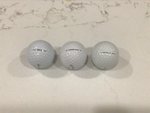Jeff58
New member
- Joined
- Mar 26, 2020
- Messages
- 21
- Reaction score
- 22

This is an on-course review of the Chrome Soft (CS) 2020, and how it compares to the V1 and TP5. I usually play the TP5. My understanding of how the 2020 Chrome Soft differs from prior models is limited.
Executive summary-
The ball went straight at the expected height for the expected distance - V1
The shot came off better than I thought it would or could - TP5
I hit a lot of good shots and felt good about my game, and had fun - Chrome Soft
Every ball has a portfolio of play characteristics that are not easily described by statistics. Some, such as the e6 series, are highly biased. Tour-level models can’t afford to be. In some ways these traits may make them a better ball generically, in others they’re personal preference. For better or worse, the Chrome Soft is more of an individual than the other two here. The two most significant differences are feel and trajectory.
Feel - The Chrome Soft is far softer in feel than the V1 or TP5 off of every club. It’s sound is also more muted and lower in frequency. Personally, I don’t play a ‘clicky’ ball. The problem with ‘clicky’ is that every shot clicks. It blinds you to your impact quality. A communicative ball, like the V1 or TP5, speaks volumes, which I find useful. The Chrome Soft, for me, moves a bit in the opposite direction. Everything is a little soft. Marginal impacts are obviously more pleasant. My irons are P790’s and driver M6. I consider them neither overly hard nor soft. In this regard, the Chrome Soft seems biased towards harder game improvement gear and/or slower swing speeds. The CS’s energy transfer (or rebound) feel on the other hand, is not soft, and in this regard is the most obvious change from the prior version, which I would call ‘composed’. The 2020 reminds me of the Cobra F9 driver. The feeling is of greater dwell time on the club face and an energetic or lively rebound. To me, the combination of lively and soft produces an ‘I’m kicking ****’ reaction, but not one of poise and control.
Trajectory - The standard for optimal distance trajectory for most swing speeds with driver is the high launch, low spin model. The Chrome Soft supports this approach to a greater degree than the others, to the point that every club takes on this characteristic to some extent. As with feel, this may benefit some players (slower SS, difficulty achieving height) more than others. However, this type of flight doesn’t provide the degree of distance repeatability as (particularly) the V1, and isn’t really optimal for short irons or full wedges.
Short game - For literally any shot from around 40 yards or less, the V1 is the best ball I’ve ever used. It’s ability to vary height through attack angle, wrist action, and face manipulation are just better. The TP5 and Chrome Soft are very similar to each other. That was initially surprising, as I expected the Chrome Soft to express its happy puppy / soft feel, which it doesn’t. I believe that the separation of feel isn’t a coincidence, rather a clear design choice that shows a high level of design and manufacturing control on Callaway’s part.
My feeling overall is that comparing the Chrome Soft to the V1 and TP5 isn’t apples to apples. Callaway’s target audience is not not the scratch/tour level/club champion. It’s the better player with a modest swing speed who values assistance in launch and distance, and probably plays cast game improvement clubs. Since that group outnumbers (and outspends) the elite players by orders of magnitude, it’s hard to question the logic.
If there is an aspect that’s questionable, at least to me, it’s cost. The V1 is now retailing for $52 per dozen (yes, it went up while you were asleep). The Chrome Soft is $48. The problems are that while the V1 is insultingly expensive, at least Titleist can make the argument that it’s the best manufactured and best playing ball available. Worse, the TP5 is currently selling for $34 / dozen in groups of 4. I play the TP5. The Chrome Soft just isn’t as good in too many ways. The kicker for me though, is the $18 / dozen Q Star Tour 2 (see my other post). I *believe* that the Chrome Soft is somewhat longer, and has less tendency to balloon on shorter shots. The Srixon has better feel, and they otherwise play remarkably similarly, to the point that very few would be able to differentiate them.







